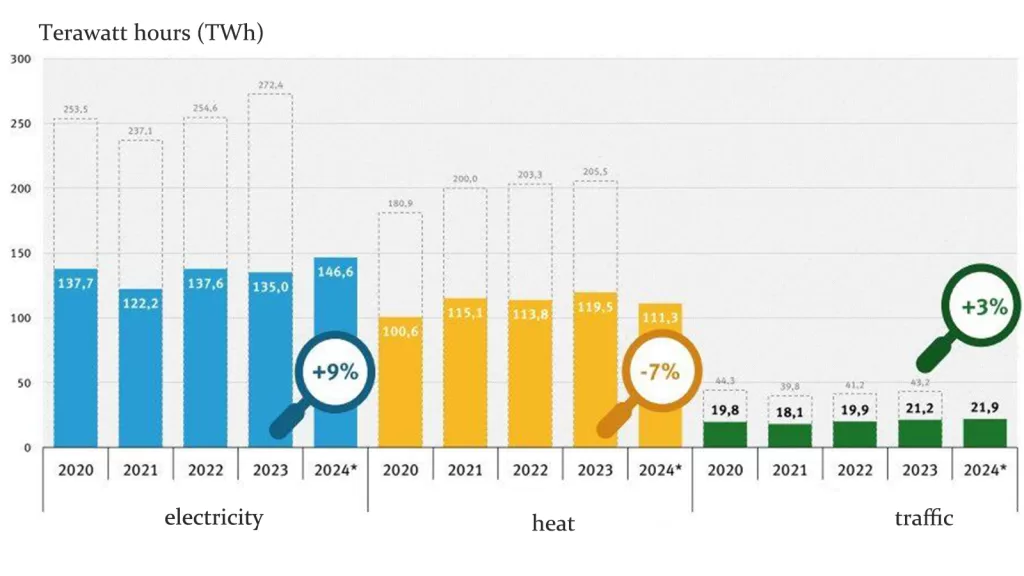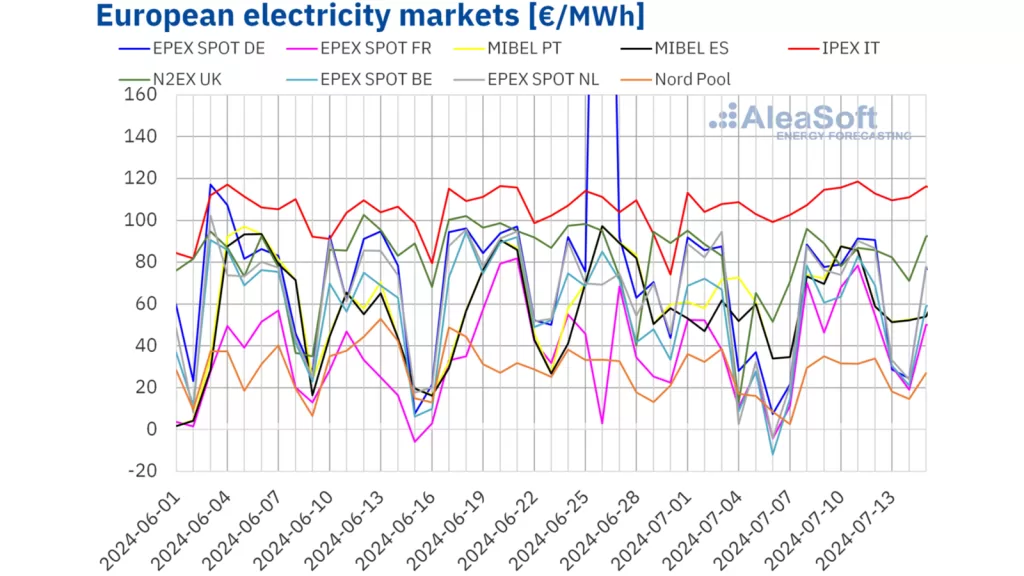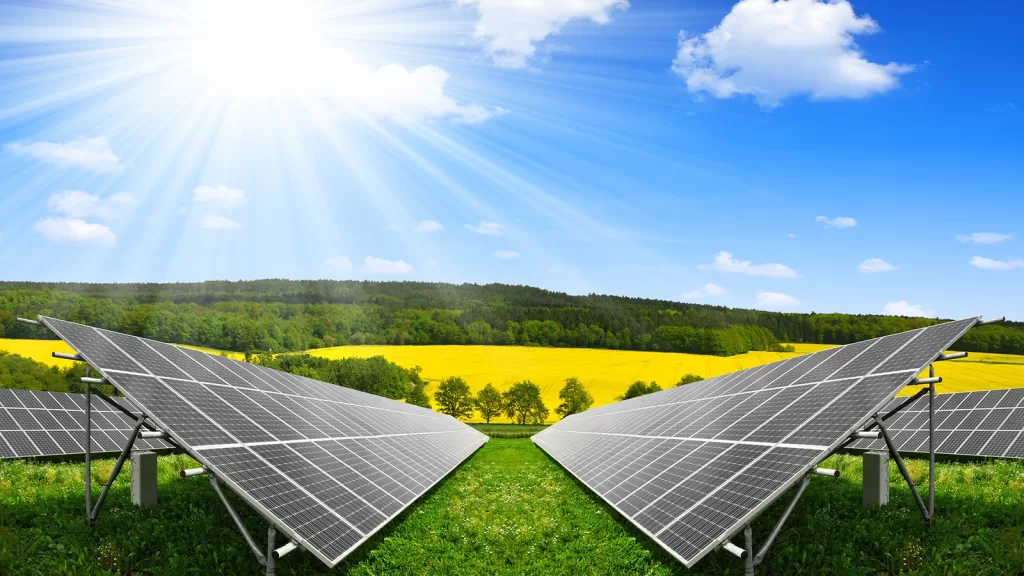Table of Contents
Renewable Energy Generation Rises While Heating and Transport Remain Unchanged

According to assessments from the first half of 2024, the share of renewable energy in power generation and consumption has been steadily increasing. The Federal Environment Agency’s Renewable Energy Statistics Working Group (AGEE-Stat) has evaluated the data, showing that renewable energy accounts for around 57% of total electricity consumption.
Compared to the first half of 2023, renewable energy generation increased by 9%, reaching approximately 147 terawatt-hours (TWh). Wind power holds the largest share of renewable energy generation at 51%, followed by photovoltaics at 24%, biomass at about 15%, and hydropower at 8%. Wind power generation increased by 10% due to windier winter conditions compared to the same period last year. In terms of photovoltaics, expansion compensated for the lack of sunshine in the first quarter, resulting in a 13% increase in solar power generation.
The working group noted that it is currently impossible to predict the annual share of renewable energy, as the output of photovoltaics and wind power depends on weather conditions, and electricity consumption trends also play a role.
In the first half of the year, photovoltaic generation saw robust growth, reaching 7.5 gigawatts (GW). In contrast, onshore wind power increased by only about 900 megawatts (MW) and offshore wind power by 400 MW. With this expansion, photovoltaic capacity has surpassed the planned cumulative generation target of 84 GW for the end of 2024, reaching about 90 GW. On the other hand, wind power currently stands at around 62 GW, making it unlikely to reach the 69 GW target by year-end.
Dirk Messner, President of the UBA, stated that the expansion data clearly indicate the need for further significant efforts. In the photovoltaic sector alone, an increase of about 50% is needed to meet the targets of the Renewable Energy Act. He emphasized that careful planning and further development of financing mechanisms are crucial for success and warned that rising grid fees would impose additional burdens, especially in regions with many renewable energy systems.
Despite the significant role of renewable energy in power generation, its presence in heating and transport remains limited. The report states that renewable energy generated 111 TWh of electricity in the first half of 2024, with the total heat provided by renewable sources decreasing by 7% compared to the same period last year.
The increase in heat pump output mitigated the overall decline in renewable heating, with a notable rise in installations in the second half of the year. Near-surface geothermal and ambient heat increased by about 3% year-on-year. However, heat pump sales have recently dropped significantly. According to the Federal Environment Agency, reversing this trend is essential to meet the target of installing 500,000 heat pumps annually. The report indicates that about 75% of renewable heating comes from biomass, 6% from biowaste, and 4% from solar thermal systems.
AGEE-Stat data shows that 21.9 TWh of transport energy came from renewable sources in the first half of this year, a 3% increase compared to the same period last year. The use of renewable electricity in transport rose by 16% due to the increased number of electric vehicles, while biofuel usage remained stable. According to the Federal Environment Agency, renewable electricity used in transport is almost equivalent to 3% of Germany’s green electricity consumption, with about 30% used in rail transport and 30% in road transport.
Germany Adds 7.55 GW of Solar Capacity in H1 2024

According to PV International, the German Federal Network Agency (Bundesnetzagentur) reported registering 1,136.9 MW of new photovoltaic systems by June 2024. This compares to 946 MW of new grid capacity in May 2023 and 1,046.8 MW in June 2023.
In the first half of 2024, Germany installed a total of 7.55 GW of new solar capacity, up from about 6.26 GW in the same period last year. By the end of June, the cumulative solar capacity in Germany had reached 90.2 GW, spread across approximately 4.25 million solar systems.
Bavaria saw the strongest growth, adding about 1.76 GW of new solar capacity in the first half of the year. It was followed by Baden-Württemberg with 1.07 GW and North Rhine-Westphalia with 1.02 GW.
Portugal and Spain Set New Solar Power Generation Records

According to AleaSoft energy forecasts, electricity prices across all major European markets rose in the second week of July. Italy saw the smallest increase at 7%, while France experienced the largest jump at 95%. Markets in Belgium, the UK, the Netherlands, Germany, the Nordics, Portugal, and Spain also saw weekly price increases.
All markets, except the UK (€84.16/MWh) and Italy (€112.83/MWh), had weekly average prices below €70 ($76.60/MWh), with the Nordics having the lowest average price at €27.79/MWh. The UK and Italy were the only countries not to experience negative electricity prices last week. Belgium and France saw the lowest hourly prices on July 14, reaching -€74.02/MWh.
AleaSoft attributed the price increases in the second week of July to a drop in wind energy production and higher electricity demand across most markets. The company forecasts a slight decrease in prices for most markets in the third week of July due to reduced demand.
Solar power generation saw significant growth last week, with Germany up by 23%, France by 16%, Italy by 12%, Spain by 5.7%, and Portugal by 1.7% compared to the previous week. Spain set a new record for daily solar output on July 12, reaching 208 GWh, while Portugal set its own record on July 13 with 23 GWh. France and Germany also broke their July daily solar generation records, reaching 121 GWh and 405 GWh on July 8 and 9, respectively.
AleaSoft predicts that solar output in Germany will continue to rise in the third week of July, while solar generation in Italy and Spain is expected to decline.
Market Slump Keeps Polysilicon Prices Stable at Low Levels

The global polysilicon market price (GPM), the OPIS benchmark for polysilicon outside China, is currently assessed at $22.567 per kilogram this week, unchanged from the previous week despite some trading activity.
A source familiar with the global polysilicon market reported that spot polysilicon has been nearly sold out for two months, with downgraded materials in even worse condition. However, global polysilicon suppliers have not yet cut production. Customers with long-term contracts are also under pressure to secure supplies at relatively stable prices. “Long-term contracts are meant to protect both parties and shift all risks to one side. Avoiding risks entirely shows a lack of contractual commitment,” said a supplier.
According to Chinese sources, a Chinese wafer manufacturer is currently operating at a 30% low utilization rate domestically and is moving wafer slicing equipment to Laos, with plans to possibly increase ingot production capacity in the future. This development could open new sales channels for global polysilicon.
Sources revealed that due to a decline in solar product output from four Southeast Asian countries, global polysilicon ingot production can now consume less than 1,500 tons of polysilicon material per month. Additionally, new ingot factories outside these countries have insufficient capacity to significantly boost global polysilicon demand.
A market observer stated, “We anticipate that polysilicon ingot capacity outside China and the four Southeast Asian countries will grow significantly in the coming years, bringing new factors that could influence global polysilicon prices.” However, the observer also noted that U.S. trade policies will remain a key factor in determining global polysilicon price trends over the next two years.
According to OPIS, the price of mono-crystalline silicon in China has remained steady this week at 33 RMB per kilogram ($4.54), marking the sixth consecutive week of stability. Market sources indicate that major polysilicon manufacturers have halted price reductions, which helps stabilize mainstream market prices. “Polysilicon prices are likely to remain stable at their current low level in the near term,” a source added.
Upstream sources report that a well-capitalized, high-utilization manufacturer is actively expanding its new polysilicon capacity in Yunnan to 200,000 tons per year. Additionally, a new 200,000-ton polysilicon plant in Inner Mongolia is under construction and is expected to start operations in Q4 of this year. “However, due to the current market slump, the Inner Mongolia project may face some obstacles,” commented a market veteran.
Another market observer noted that despite the lower production costs of fluidized bed reactor (FBR) granular polysilicon, manufacturers cannot maintain high utilization rates due to the product’s limited market share. “China has two FBR granular polysilicon manufacturers engaged in production and sales, and another operates a research and trial production line,” the source added.
Market insiders suggest that, given the current downstream utilization rates, effectively depleting polysilicon inventory by the end of the year will be challenging, and polysilicon production is expected to decline further in the second half of the year.
German Researchers Develop ‘communicative’ Solar Panels

On the rooftop of the Helmholtz Centre for Solar Energy Research (ISFH) in Germany, solar modules have been installed and connected to form a network of multiple sub-networks. This technology is being tested for its effectiveness in Building Integrated Photovoltaics (BIPV) applications, which often involve small areas, various layouts, or shaded regions. Integrated electronic components within the modules can control and monitor each module according to changing radiation conditions, while the entire system remains accessible to grid operators.
Funded by the German Federal Ministry for Economic Affairs and Climate Action, this project began in March 2020 with the goal of developing new “smart” solar power solutions. Project coordinator Jens Friebe from Leibniz University Hannover explained, “The aim is to directly integrate inverters and digital technology into the solar modules to enhance reliability, increase efficiency, and reduce costs.” Wireless communication and flexible network setups facilitate rapid installation and potentially lower costs for mass production.
The fully integrated solar modules developed for Voyager-PV include microinverters and wireless technology operating in the unlicensed 2.4 GHz frequency band, enabling connectivity between modules and gateways. Software updates can also be carried out wirelessly within the network.
Specialized project partners developed the necessary slot antennas, powered by capacitive coupling through circuit boards on the module’s back. The German engineering firm WHO provided the radio technology, while the High-Frequency Technology and Radio Systems Institute at Leibniz University Hannover developed the slot antenna solutions. Encapsulation technology expert Optimel handled the encapsulation of the electronic components. Connecting power electronics directly to a single solar cell string eliminates the need for bypass diodes, reducing the likelihood of defects and improving energy yield.
Leibniz University Hannover’s Drive Systems and Power Electronics Institute developed power electronics using Gallium Nitride (GaN) power semiconductors for the inverters. SMA Solar Technology contributed expertise in inverter and system technology, while the University of Stuttgart focused on reliability. ISFH is responsible for research into photovoltaic module technology.
Since May, the Helmholtz demonstration system has been transmitting data, allowing for the monitoring of power electronics and the reading of operational data such as module current, voltage, and temperature. Researchers stated, “Establishing a mesh network at ISFH demonstrates the stability and self-optimization of communications across multiple solar modules.” Project participants can simultaneously access the network from their respective locations.
Maysun Solar has been specialising in producing high quality photovoltaic modules since 2008. In addition to the Balcony Solar Power Station, Maysun Solar offers wide variety of full black, black frame, silver, and glass-glass solar panels that utilise half-cut, MBB, IBC, and HJT technologies. These panels offer superior performance and stylish designs that seamlessly blend in with any building. Maysun Solar successfully established offices, warehouses, and long-term relationships with excellent installers in numerous countries! Please contact us for the latest module quotations or any PV-related inquiries. We are excited to assist you.
Reference:
Enkhardt, S. (2024b, July 17). Erneuerbare Stromerzeugung steigt – Wärme und Verkehr konstant. Pv Magazine Deutschland. https://www.pv-magazine.de/2024/07/17/erneuerbare-stromerzeugung-steigt-waerme-und-verkehr-konstant/
Enkhardt, S. (2024c, July 17). L’Allemagne a déployé 7,55 GW d’énergie solaire au premier semestre 2024. Pv Magazine France. https://www.pv-magazine.fr/2024/07/17/lallemagne-a-deploye-755-gw-denergie-solaire-au-premier-semestre-2024/
Polysilicon prices stabilize at low levels amid market downturn. (2024, July 12). Pv Magazine International. https://www.pv-magazine.com/2024/07/12/polysilicon-prices-stabilize-at-low-levels-amid-market-downturn/
Jowett, P. (2024e, July 17). Portugal, Spain set records for daily solar energy production. Pv Magazine International. https://www.pv-magazine.com/2024/07/17/portugal-spain-set-records-for-daily-solar-energy-production/
Siemer, J. (2024, July 16). German researchers develop ‘communicative’ PV panels. Pv Magazine International. https://www.pv-magazine.com/2024/07/16/german-researchers-develop-communicative-pv-panels/
Recommend Reading:

Empowering Factories with Solar Energy A Strategic Tool for Controlling Production Electricity Costs
Commercial and industrial solar is becoming a key solution for factories to reduce electricity costs and hedge against price fluctuations. This article systematically analyzes its deployment models, cost advantages, and sustainable value pathways.

How Businesses Can Offset Carbon Taxes with Solar Power
This article analyzes the latest carbon tax policies and photovoltaic deduction strategies, helping European businesses legally reduce taxes, increase profits through solar investment, and achieve a win-win situation for both economy and environment.

Forecast and Response: Seizing the Next Decade’s Growth Dividend in Europe’s Commercial and Industrial Photovoltaics Market
Maysun Solar analyzes the growth trends of commercial and industrial photovoltaics in Europe over the next ten years, from policies and ESG to technological innovation, helping companies seize the initiative in the energy transition.

How to Calculate Solar System ROI and Optimize Long-Term Returns?
Solar power is becoming a key solution for businesses to reduce costs and improve efficiency. Accurately calculating ROI and optimizing long-term returns are essential to maximizing investment value.

Will Agrivoltaics Affect Crop Growth?
Agrivoltaics combines solar energy and agriculture to reduce up to 700 tons of CO₂ per MW, improve water use, and boost crop growth for sustainable farming.

6.5 Billion Loss Hits Photovoltaics: Reshaping or Elimination?
In 2025, the photovoltaic market may see a turnaround as some companies take early action. A €6.5 billion loss is driving businesses to explore new growth areas like energy storage and hydrogen. Which giants will break through? Industry transformation is accelerating!



